CC076
Human Collagen Type IV
from human placenta, liquid, 1 mg/mL, suitable for cell culture, used for gel formation
About This Item
Polecane produkty
product name
Human Collagen Type IV,
pochodzenie biologiczne
human
Poziom jakości
Próba
95% (Human collagen type IV, SDS-PAGE)
Postać
liquid
masa cząsteczkowa
300 kDa
producent / nazwa handlowa
Chemicon®
stężenie
1 mg/mL
metody
cell culture | mammalian: suitable
zanieczyszczenia
<5% Human collagen types I-III, V, VI, and non-collagen proteins
moc wejściowa
sample type epithelial cells
sample type hematopoietic stem cell(s)
sample type pancreatic stem cell(s)
sample type neural stem cell(s)
sample type mesenchymal stem cell(s)
sample type induced pluripotent stem cell(s)
sample type: human embryonic stem cell(s)
rozpuszczalność
water: soluble at 20 °C
numer dostępu NCBI
numer dostępu UniProt
Specyficzność wiązania
Peptide Source: Laminin
Peptide Source: Nidogen
Warunki transportu
dry ice
temp. przechowywania
−20°C
informacje o genach
human ... COL4A1(1282)
Powiązane kategorie
Opis ogólny
Zastosowanie
Działania biochem./fizjol.
Postać fizyczna
Przechowywanie i stabilność
Komentarz do analizy
Informacje prawne
Oświadczenie o zrzeczeniu się odpowiedzialności
Kod klasy składowania
12 - Non Combustible Liquids
Klasa zagrożenia wodnego (WGK)
WGK 1
Temperatura zapłonu (°F)
Not applicable
Temperatura zapłonu (°C)
Not applicable
Certyfikaty analizy (CoA)
Poszukaj Certyfikaty analizy (CoA), wpisując numer partii/serii produktów. Numery serii i partii można znaleźć na etykiecie produktu po słowach „seria” lub „partia”.
Masz już ten produkt?
Dokumenty związane z niedawno zakupionymi produktami zostały zamieszczone w Bibliotece dokumentów.
Klienci oglądali również te produkty
Produkty
Białka macierzy zewnątrzkomórkowej, takie jak laminina, kolagen i fibronektyna, mogą być stosowane jako podłoża do mocowania komórek w hodowli komórkowej.
Extracellular matrix proteins such as laminin, collagen, and fibronectin can be used as cell attachment substrates in cell culture.
Protokoły
Ta strona obejmuje protokoły powlekania ECM opracowane dla czterech rodzajów ECM na wkładkach Millicell®-CM, kolagenu typu 1, fibronektyny, lamininy i matrigelu.
This page covers the ECM coating protocols developed for four types of ECMs on Millicell®-CM inserts, Collagen Type 1, Fibronectin, Laminin, and Matrigel.
Nasz zespół naukowców ma doświadczenie we wszystkich obszarach badań, w tym w naukach przyrodniczych, materiałoznawstwie, syntezie chemicznej, chromatografii, analityce i wielu innych dziedzinach.
Skontaktuj się z zespołem ds. pomocy technicznej









